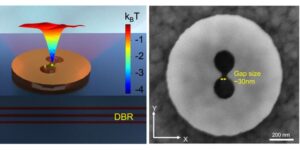The research by Ndukaife and his collaborators was recently published in Nano Letters Scientific journal. The research was done in collaboration with the lab of Vanderbilt Professors Robert Coffey and Kasey Vickers.
Extracellular vesicles and particles (EVPs) – including recently discovered exomeres and supermeres – are thousands of times smaller than the thickness of a human hair. By trapping and manipulating them, researchers aim to better understand how cells package molecules and interact with one another, which may also shed light on the formation of diverse diseases, like cancer and Alzheimer’s.

Optical trapping of single extracellular vesicles and supermeres using optical anapoles.
However, when using optical tweezers, there’s a risk of photothermal heating that could adversely affect the EVPs. In their paper, Ndukaife and his team discuss using an anapole antenna to condense the electromagnetic energy to the nanoscale and successfully trap EVPs using a lower laser power.
“Since the proposed trapping system is low-loss, it precludes local temperature rises and thus ensures that important biological particles and molecules remain intact,” according to the paper.
Ndukaife recently received the Maximizing Investigators’ Research Award of $1.9 million from the National Institute of General Medical Sciences to support his project, “Understanding the heterogeneity of nanoscale extracellular vesicles, exomeres and supermeres using next generation optical nanotweezers.”
The development of optical tweezers was recognized with the 2018 Nobel Prize in Physics for their efficacy in trapping single cells and larger EVs. Ndukaife developed the first-ever opto-thermo-electrohydrodynamic tweezer (OTET) that can trap and manipulate objects on the sub-10 nanometer scale at Vanderbilt in 2020.
Read the original article on Vanderbilt University.







